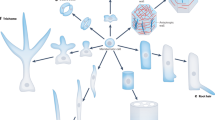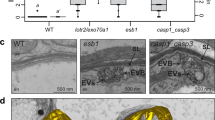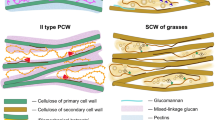Abstract
Abbe and Crafts1 showed that the development of secondary walls in the sieve cells of gymnosperms is apparently restricted to the Abietineae; there is no evidence of secondary wall in the sieve cells of Taxodineae, Araucarineae, Cupressineae and Taxineae. Moreover, the Abietineae develop no fibres, but the secondary walls of their sieve cells appear to be composed of relatively pure cellulose. Secondary walls occur in the sieve cells of white pine, Pinus strobus L. (Figs. 3 and 24 in ref. 1).
This is a preview of subscription content, access via your institution
Access options
Subscribe to this journal
Receive 51 print issues and online access
$199.00 per year
only $3.90 per issue
Buy this article
- Purchase on Springer Link
- Instant access to full article PDF
Prices may be subject to local taxes which are calculated during checkout
Similar content being viewed by others
References
Abbe, L. B., and Crafts, A. S., Bot. Gaz., 100, 695 (1939).
Barghoorn, E. S., and Scott, R. A., Amer. J. Bot., 45, 222 (1958).
Johansen, D. A., Plant Micro-Technique (McGraw-Hill Book Co., New York and London, 1940).
Author information
Authors and Affiliations
Rights and permissions
About this article
Cite this article
MAHMOOD, A. Secondary Walls in Phloem of Pinus radiata D. Don. Nature 207, 657–658 (1965). https://doi.org/10.1038/207657a0
Published:
Issue Date:
DOI: https://doi.org/10.1038/207657a0
Comments
By submitting a comment you agree to abide by our Terms and Community Guidelines. If you find something abusive or that does not comply with our terms or guidelines please flag it as inappropriate.



